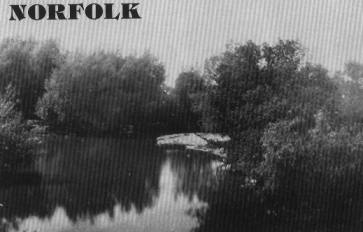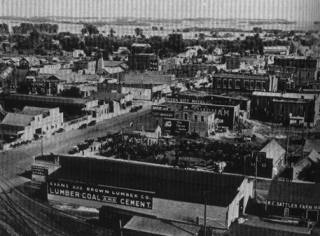 NORFOLK
-- MADISON COUNTY NORFOLK
-- MADISON COUNTY
Little did the first settlers on the North Fork of
the Elkhorn
River dream that their town would become one of
Nebraska's 12
largest cities. They were simply looking for a new
place to live.
A major disagreement within a Lutheran congregation
in Ixonia,
WI, prompted a number of families, led by The
Rev.Hoeckendorf, to
resettle on the prairies in Nebraska Territory. A
committee was
sent to find a suitable location for the colony in
this "new
promised land" in 1865. The next spring, 44 families
packed
all their earthly possessions into wagons and
started for the
fertile Elkhorn Valley.
Starting in May, they arrived at the confluence of
the Elkhorn
and North Fork rivers on July 17. The land was
divided into equal
shares of 160 acres for each family. Their homes
included
dug-outs, sod houses, and log cabins (or a
combination of these)
and roofed with slough grass.
Their late arrival meant that no crops could be
raised that
season. Food and supplies were a great distance away
and prices
were very high. The people endured many hardships,
denials, and
disappointments, but noted, "...sure as there is a
sky
above, the Lord has placed in the midst of the
beautiful prairie
a variety of wild fruits, game, and fowl to sustain
us until
crops can be planted and a harvest brought in."
This group of good German farmers was so well
established by
the spring of 1868 that they petitioned Congress for
a post
office for the settlement, named "North Fork."
However,
authorities, thinking it was misspelled, issued the
permit for
"Norfolk" and appointed August Raasch postmaster.
(Nebraskans, however, pronounce it Nor-fork.)
The first store (a soddy with a log front) was
located where
the Elkhorn and North Fork rivers join, and was kept
by a man
named Jones. Indians often came through the valley
on hunting
expeditions. The Ponca and the Omaha tribes made
yearly visits to
the area, and would stay several weeks, trading
ponies, buffalo
robes, and moccasins for blankets, knives, guns,
powder, shot,
beads, and other items.
In 1868 Colonel Charles Mathewson arrived with his
family,
which included several grown children. The colonel's
appointment
at the Winnebago and Omaha Reservation had expired,
and he was
searching for "a new profitable location." Finding
this
settlement in need of lumber and a grist mill, he
decided to
stay.
A makeshift sawmill was made by digging a hole in
the ground
deep enough for a man to stand. A log was then
placed in a rack
across the top of the hole. Using a two-man saw with
one man in
the hole and the other at the ground level, they
pulled the blade
back and forth through the log, cutting it into
planks.
As soon as Mathewson had built a frame house for
his family,
he put up a mill store. Opened in February 1869, it
was run by
his son-in-law, John Emery Olney. Construction was
then started
on the grist mill, completed in February 1870.
The location of the grist mill and mill store
actually
determined the present location of Norfolk. With
these basic
businesses located, the colonel drew out a design
for lots.
Herman Braasch engaged the county surveyor, Thomas
Ward, to lay
out the town site. A public square was included, for
the
hoped-for county courthouse.
 A host of
new citizens arrived in the 1870s. John Koenigstein
opened a drug
store, Ferdinand Wegener built a "real hotel,"
August
Pilger started a hardware store, and John Oesterling
had a
harness shop. Fred Lehman set up a blacksmith forge
in 1871. The
next year a newspaper, "The Pioneer," was
established.
Written by hand, it was edited by Charles Mathewson
and Mary
Fish, and published "semi-occasionally." A host of
new citizens arrived in the 1870s. John Koenigstein
opened a drug
store, Ferdinand Wegener built a "real hotel,"
August
Pilger started a hardware store, and John Oesterling
had a
harness shop. Fred Lehman set up a blacksmith forge
in 1871. The
next year a newspaper, "The Pioneer," was
established.
Written by hand, it was edited by Charles Mathewson
and Mary
Fish, and published "semi-occasionally."
Blizzards in the spring of 1873 were devastating.
The summer
brought another disaster -- prairie fire. As the
flames raced
toward the settlement, threatening the business
district, women
worked shoulder to shoulder with the men, pumping
tubs full of
water and flailing the burning stubble with
water-soaked sacks or
blankets. The town was saved, but crops, livestock,
and many
homesteads were not.
Grasshopper invasions had come to parts of the
plains states
on numerous occasions, but hit northeastern Nebraska
hardest in
1874. Fear of their return left many people feeling
helpless in
the face of such overwhelming obstacles.
The hope that Norfolk would be named as the county
seat was
dashed the following year when the election went to
a town more
centrally located. However, the gold rush to the
Black Hills from
1876-78 quickly made Norfolk the "gateway to the
northwest." The trail up the Elkhorn Valley, and
then across
to the Niobrara cut miles off the route along the
Platte to
Sidney and then north. Norfolk became a stopping
point for
freighters, where provisions could be purchased for
the long
journey west. Supplies went to the end of the
extending rail
line, and then were rushed on to Norfolk by wagon.
The Fremont, Elkhorn & Missouri Valley Railroad
arrived in
September 1879, and the next year the Union Pacific
completed its
line from Columbus. The appearance of two major
railroads, and
eventually a third, the Chicago, St.Paul,
Minneapolis &
Omaha, out of Sioux City, were eminently more
important to
Norfolk's destiny as a trade center than being the
county seat.
With all the activity and growth, the town asked to
incorporate. In September 1881 a village board was
elected.
Streets and alleys were dedicated, lamps were
erected on major
thoroughfares, and by 1884 a fire department was
organized.
In 1888 the Legislature appropriated funds to build
the State
Hospital for the Insane in Norfolk. Although only
limited
treatment methods were known at the time, this
institution grew
and at one time accommodated over 1,400 residents.
With good rail connections and power, Norfolk had a
sugar beet
factory from 1891 to 1904. From 1915-25 Norfolk was
the home of
the Square Turn Tractor Company, which produced
machinery that
helped mechanize farming. Manufacturing and industry
grew and
Norfolk flourished with the increasingly diversified
economy.
Currently more than 40 manufacturing plants produce
a wide
variety of products and employ over 3,000 people.
Located at the
junction of two major highways and two railroad
lines, Norfolk
continues to be a major transportation center for
northeast
Nebraska.
Norfolk is the hometown of a number of famous
people:
-- Johnny Carson, host of the "Tonite Show" lived
here and graduated from Norfolk High School.
-- George L. Carlson became a world renowned
geologist,
explorer, and editor. A horse-breeder, he is
credited with the
introduction of artificial insemination of
livestock.
-- Dr. Richard J. Tanner was also widely known as
"Diamond Dick," hero of countless ten-cent western
novels. World champion long distance rider and sharp
shooter in
the 1890s, he lived in Norfolk from 1910-43.
-- Joyce Hall, founder of the Hallmark Company,
started the
firm Norfolk Post Card Company in 1908.
As the hub of northeast Nebraska, Norfolk is unique
as an
economic center for that part of the state. Named
"All-America City" in 1975, it was a finalist again
in
1980, and has been an "All-Nebraska City" every year
since 1977.
 The 1980
census lists Norfolk with a population of 19,449 and
still
growing. A city of the first-class, our town is
keeping up with
the ever-changing times through the watchful eyes of
its
agricultural and industrial base. The 1980
census lists Norfolk with a population of 19,449 and
still
growing. A city of the first-class, our town is
keeping up with
the ever-changing times through the watchful eyes of
its
agricultural and industrial base.
By Mary A. Voss, 721 East Park Avenue, Norfolk, NE
68701
ADDITIONAL MATERIAL: Koxie Comie, 1886-1986,
Norfolk
Centennial, 1966; Souvenir of Norfolk, 1894; Norfolk
of Today
1894; A History of Norfolk , by Pangel, 1929; "Early
History
of Norfolk & Madison County Towns," 1938, by
Langraff; A
Nostalgic Tour & Trivia of Norfolk, (before
1900), by Cobb
and Robinson, 1979; History of Norfolk Livestock
Sales Company,
1919-77, by Barritt, 1977; Norco News 100th
Anniversary, 1969;
Methodism in Norfolk , Hess, 1947; Heritage of the
United
Methodist Parish, Moody, 1984; and "Norfolk: Where
Industry
Meets Instant Success," 1967, B & I Magazine.
Information also found in: History of Nebraska,
1882, Andress;
History of the Elkhorn Valley, 1892, Scoville; End
of the track ,
by Kyner, 1937; and Nebraska, A Guide to the
Cornhusker State , a
WPA project, 1939, 1947. Newspaper articles from
"Norfolk
Daily News," "Anzeiger," "Daily Times,"
"Herald," "Journal," "Press," and
"Norfolk Weekly News Journal."
|



